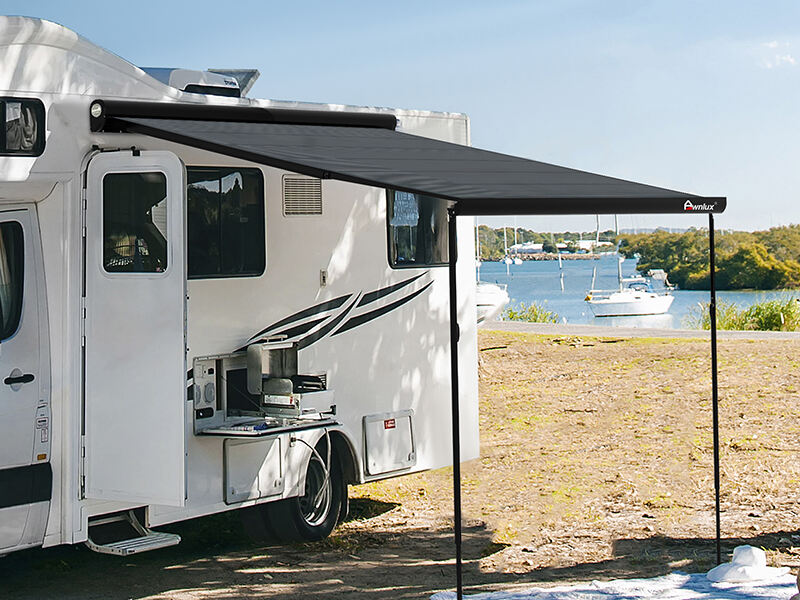There is a revolution in a permanent energy movement how RV and Special Vehicle Area operates. The manufacturers aim to reduce their carbon emissions by improving self-governing capabilities, causing solar awnings to become an industrial solution that provides protection from sunlight when generating renewable power. This technique has developed as a fundamental business requirement for future-oriented businesses.
1. Dual-Function Design: Shade + Energy Harvesting
The solar-acquired awnings made the functionality wider by converting stable elements into dynamic power generation units. Flexible photovoltaic (PV) panels produce embedded electricity in clothing and provide UV protection to users at the same time. The modern solar-power system consists of ultra-splutter light PV movies that fit without any wholesale for the current RV structure.
Such solar awnings that measure 10 feet in length, generate 150 to 300 watts per day to provide electricity to lighting equipment with equipment and supportive batteries. Disaster relief units as well as specific mobile clinics can survive using their own energy production to stay in operations.
2. Engineering Challenges and Breakthroughs
Solar awnings from the past faced short service life challenges as research and development has successfully resolved these problems.
Weather Resistance: Weather Resistance gets achieved through modern laminating processes which shield PV cells against hail damage and protect them from rain and limit sand erosive effects. The leading suppliers expose fabrics to salt spray tests lasting more than 1000 hours to evaluate their resistance to coastal corrosion.
Flexibility Without Fatigue: The continuous opening and closing of solar-equipped awnings leads to potential damage to rigid solar panels through cracking. Flexibility has transformed monocrystalline silicon PV cells through mounting them on flexible polymer substrates which perform 50,000+ fold operations without power degradation.
Heat Management: Solar absorption produces increased heat in rooftop structures. Aerogel insulation along with passive cooling vents exists in premium solar awnings which pass thermal chamber testing under various temperature ranges between -40°F to 200°F.
3. Compliance and Safety for Industrial Use
Exceptional safety standards must be followed by solar awnings to prevent becoming potentially dangerous to users.
Fire Ratings: The construction materials featuring PV cells must pass ISO 5660-1 flame spread testing for safety purposes in arid and high-risk zones.
EMI Shielding: Faulty EMI Shielding occurs when systems are not properly designed so they affect vehicle electronic systems. The best products integrate electromagnetic shielding components which pass anechoic chamber testing protocols.
Load Testing: The engineers conduct load tests to simulate wind speeds of 75 mph against snow loads reaching 35 lbs/ft² for ensuring the structures remain structurally sound when harvesting energy.
The leading companies in this field regularly make available third-party certification documents including UL 2703 for mounting systems alongside IEC 61215 for PV module reliability.
4. The ROI Equation for Manufacturers
Implementing solar awnings provides double benefits to the environment and financial resources:
Reduced Dependency: The vehicles need less shore power or generators for operation thus achieving lower fuel expenses.
Premium Pricing: Legitimate industry research indicates that vehicles with built-in solar energy systems maintain a resale value that increases between 15 and 20 percent.
Regulatory Incentives: Present and future governments use regulatory incentives to support green RV technologies because they subsidize research and development expenses.
Fleet operators investing in solar awnings reach their initial investment return within 2–3 years because of their large purchase volumes.
5. The Next Frontier: Smart Integration
The upcoming age belongs to integrated and unified systems. Prototypes in development include:
Adaptive Tracking: Via automatic tracking mechanisms PV panels attain their highest efficiency through motorized awnings which create improved results of 25–30 percent.
AI Energy Management: AI Energy Management uses predictive systems to determine how charging should be managed with respect to weather outlooks and system usage data.
Vehicle-to-Grid (V2G) Compatibility: Energy from solar power will flow into smart grids for peak demand vehicles with V2G (Vehicle-to-Grid) compatibility.
Complete product development requires an endless cycle of testing through equipment which simulates off-road movements using vibration tables along with UV accelerate testers shortening ten-year degradation to months.
Why Testing Labs Are Non-Negotiable
Solar awning success hinges on precision validation. The industry pioneers use their own testing facilities that contain:
Solar Simulators: Energy measurement tests during controlled conditions use solar simulators to duplicate complete sunlight intensity.
Cyclic Mechanical Testers: The testing equipment known as cyclic mechanical testers operates to simulate material fatigue throughout numerous deployment/retraction cycles.
Environmental Chambers: Expose systems to monsoons, blizzards, and desert droughts in one facility.
Warranty costs along with trust erosion become possibilities when manufacturers lack proper infrastructure.
Final Insight
The innovation behind solar awnings not only creates technological progress, but also enables energy self-reliance in the mobile system. RV and special vehicle manufacturers, who adopt solar awnings in the initial stages, achieve market competition because stability and smart technology run the current industry trends. Future vehicles will transport more than individuals as they together will generate their own power energy sources according to industry experts.

 EN
EN
 AR
AR HR
HR CS
CS NL
NL FI
FI FR
FR DE
DE EL
EL HI
HI IT
IT JA
JA KO
KO NO
NO PL
PL PT
PT RO
RO RU
RU ES
ES SV
SV TL
TL ID
ID SR
SR SL
SL UK
UK VI
VI SQ
SQ HU
HU MT
MT TH
TH TR
TR MS
MS AZ
AZ KA
KA LO
LO MN
MN MY
MY KK
KK KY
KY

